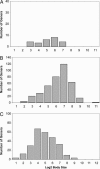Assessing the fidelity of the fossil record by using marine bivalves
- PMID: 16617108
- PMCID: PMC1458929
- DOI: 10.1073/pnas.0601264103
Assessing the fidelity of the fossil record by using marine bivalves
Abstract
Taxa that fail to become incorporated into the fossil record can reveal much about the biases of this record and provide the information needed to correct such biases in empirical analyses of the history of life. Yet little is known about the characteristics of taxa missing from the fossil record. For the marine Bivalvia, which have become a model system for macroevolutionary and macroecological analysis in the fossil record, 308 of the 1,292 living genera and subgenera (herein termed "taxa") are not recorded as fossils. These missing taxa are not a random sample of the clade, but instead tend to have small body size, reactive shell structures, commensal or parasitic habit, deep-sea distribution, narrow geographic range, restriction to regions exposing few Neogene marine sediments, or recent date of formal taxonomic description in the neontological literature. Most missing taxa show two or more of these features and tend to be concentrated in particular families. When we exclude the smallest taxa (<1 cm) and deep-sea endemics, date of published description and geographic range become the strongest predictors of the missing taxa; other factors are statistically insignificant or have relatively small effects. These biases might influence a variety of analyses including the use of fossil data in support of phylogenetic analyses, molecular clock calibrations, and analyses of spatial and temporal dynamics of clades and biotas. Clade inventories such as these can be used to develop protocols that minimize the biases imposed by sampling and preservation.
Conflict of interest statement
Conflict of interest statement: No conflicts declared.
Figures

References
-
- Darwin C. On the Origin of Species by Means of Natural Selection. London: Murray; 1859.
-
- Sepkoski J. J., Jr. Paleobiology. 1981;7:36–53.
-
- Jablonski D., Roy K., Valentine J. W., Price R. M., Anderson P. S. Science. 2003;300:1133–1135. - PubMed
-
- Kidwell S. M. Science. 2005;307:914–917. - PubMed
-
- Schopf T. J. M. Paleobiology. 1979;4:261–270.
Publication types
MeSH terms
LinkOut - more resources
Full Text Sources

